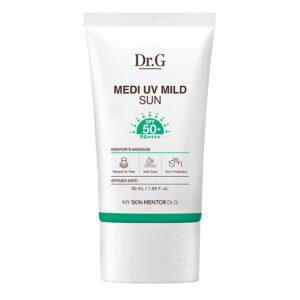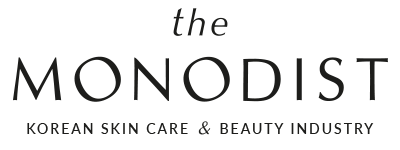dr.g
Medi UV Mild Sun SPF50+/PA++++

Product overview
Brand: Dr.G
Product name: Medi UV Mild Sun SPF50+/PA++++
Korean Product Name: 메디 UV 마일드 선 SPF50+/PA++++
Protection: SPF50+/PA++++
Water resistance: Not water resistant
Capacity: 50ml
Formulated by: Kolmar Korea
Manufactured by: Kolmar Korea
Distributed by: Gowoonsesang Cosmetics
Country of Manufacture: South Korea
Functional Cosmetic Certifications: UV Protection
Original Retail Price: 36,000 KRW
Date of Release: March 2021
Shelf life: 30 months before opening. 12 months after opening
Ingredients
Sunscreen type: Mineral sunscreen (inorganic UV filters)
UV Filters: Zinc Oxide.
Notable allergens: n/a
Product description
Infused with Zinc Oxide and Centella Asiatica, Dr.G’s “Medi UV Mild Sun SPF50+/PA++++” is a sunscreen specifically designed for sensitive skin.
Dr.G’s “Medi UV Mild Sun SPF50+/PA++++” is a sunscreen that gently provides protection and relief for sensitive skin.
If you have sensitive skin, opt for a gentler zinc oxide sunscreen!
Our sunscreen is made with a single UV filter: the gentle Zinc Oxide. This ingredient provides strong protection against UV rays, while still being gentle on the skin.
Gentle zinc oxide offers broad-spectrum UV protection
Zinc oxide is an inorganic UV filter that offers broad-spectrum protection. This ingredient is so gentle that it’s commonly used in skincare products and is suitable even for sensitive skin.
Water Shield Powder technology: When the sunscreen comes in contact with sweat or oil, the Water Shield Powder technology repels them by mimicking the action of a waterproof coating film.
Pycnogenol promotes skin health
Extracted from pine trees that have withstood the harsh winds and intense sun along the French coast, Pycnogenol is an ingredient known to enhance skin’s natural resilience.
*The statements above only pertain to the characteristics of the raw material.
Relief for sun-exposed skin
Soothing formula infused with Centella Asiatica that provides relief for sun-exposed skin. Centella Asiatica, renowned for its soothing qualities, is blended with plant-derived ingredients that protect the skin, providing relief for UV-stressed skin.
*The statements above only pertain to the characteristics of the raw materials.
As a sunscreen designed for sensitive skin, Dr.G’s “Medi UV Mild Sun SPF50+/PA++++” was enriched with trusted soothing ingredients:
*The statements above only pertain to the characteristics of the raw materials.
Comfortable moisturising formula
Daily sunscreen with a moisturising formula that leaves a non-sticky finish. Dr.G’s “Medi UV Mild Sun SPF50+/PA++++” is a daily sunscreen with a lightweight, smooth, non-sticky formula that can be comfortably used all year round, even by those with sensitive skin.
The sunscreen boasts an airy, non -sticky formula that feels light on the skin.
Clean Beauty
“What if I want care for both my skin and the environment?” Introducing the latest trend: Clean Beauty.
Recommended for
Directions
At the last step of your skin care routine, take an adequate amount of product and apply it evenly across areas of the skin exposed to UV rays.
Precautions
- Immediately consult a dermatologist if symptoms such as red blotches, swelling and/or itchiness appear while using the product, or in case such symptoms appear when the skin is exposed to direct sunlight after use.
- Do not use the product on open wounds.
- Storage and handling precautions:
- Keep out of the reach of children.
- Keep away from direct sunlight.
Other editions and formulations
n/a
Shop this product
International retailers:
South Korean retailers:
Make sure to check out the Discount & Coupons page to access exclusive offers for major Korean skincare retailers.
